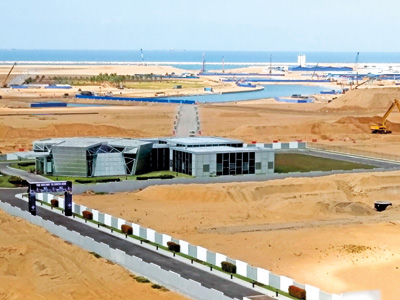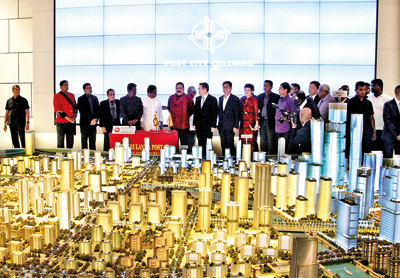News
Colombo Port City hit by vagaries of Lankan policymaking
The Colombo Port City has become an example of how even investors with the direct backing of a powerful Government can fall victim to the vagaries of Sri Lankan policymaking.
Red tape, changes in administration, geopolitics, shifting goalposts and local sensitivities are just some of the challenges the project has faced since it was launched. Land reclamation was completed in January last year, adding 269 hectares to the country’s landmass. The property was declared open to investors a full 12 months later, in December.

A view of the Port city in progress: Pix by Indika Handuwala
Yet, the promoters of Port City are constrained from making a convincing sales pitch because an essential prerequisite is still not in place: a law that will declare it to be the country’s first service-oriented special economic zone (SEZ).
Since commencement in 2014, CHEC Port City Colombo (Pvt) Ltd has a profit and loss statement that is “just accumulating cost”. Hit also by a suspension of 18 months—when the project was stopped for the attempted renegotiation of some terms—the company “hasn’t earned a single rupee yet”.
It was announced in November that project partner Urban Development Authority (UDA) would call tenders for the construction of an international school, hospital and conference hall in the Port City. It is still not done.
The Sirisena-Wickremesinghe administration moved at a snail’s pace on the proposed legislation which it said would be based on English law. The rationale was that English law, with London being a major centre of finance, was accepted in the financial world.
“The previous Government found it difficult to implement a policy which would attract the international investor community that was at the same time acceptable to the local business community,” said a source familiar with the internal workings.
It was decided Port City would be a “test case” touting specific economic and commercial legislation attractive to investors in such a way that it wouldn’t interfere with the status quo in the rest of the country. But the Government was on slippery footing, politically, and that—in addition to characteristic inertia—badly affected momentum.
“The investor has been going at it for the last two to three years and nothing came out of it,” the source said.
The law is expected to address red tape and shortcomings in approval processes within a ring-fenced, controlled environment. And if done right, it could be rolled out elsewhere, such as in Board of Investment (BOI) export processing zones.
Investors in Sri Lanka face recurrent problems. Every new administration has its quirks. They must quickly adjust to dealing with new people and their own vested interests. Sometimes key officials are replaced several times during the tenure of a single Government. There are new policies, new powerbrokers and new egos to stroke.
But the pace has now picked up. At best, the hope is for a more proactive Government, sources familiar with the project company’s thinking said. The previous Prime Minister had seemed “a little bit remote”.
On December 9, Prime Minister Mahinda Rajapaksa attended a ceremony to officially declare the reclaimed property open for investment. He not only pledged to accelerate the project, officials present there said he took instant decisions. It was his Government, after all, that had started this ball rolling.
There were issues from the start. In what was typical of the Mahinda Rajapaksa regime, rules and procedure were treated as a miserable inconvenience. The manner in which the Port City deal was executed–it was an unsolicited proposal and there were no international tenders called–was riddled with so many holes that it left room for justifiable criticism.
For instance, the agreement was forged with the Sri Lanka Ports Authority (SLPA) which had no legal authority to sign it and, therefore, to discharge those obligations. The environmental impact assessment failed to address significant concerns, including whether there would be damage to marine and coastal life. Fisher unions protested and lobbyists questioned the sand mining.
The suspension was lifted and China Communication Construction Company (CCCC), CHEC’s parent company, dropped its claim for US$ 143mn in compensation over delays. The agreement had some airtight clauses that the Government could not shift. But there were some adjustments. For instance, a supplementary EIA was taken out to plug (however shoddily) the gaps.
But a major adjustment was related to land ownership and it is clear that Indian, as well as domestic, concerns had an impact here. The original contract gave the project company freehold rights over 20 hectares and leasehold rights over 88 hectares. The SLPA and Government were entitled to 62 hectares of marketable land while the remaining 63 were for common areas such as roads, etc.
It was agreed after talks that CHEC Port City will have no longer have freehold land. Everything is on a 99-year lease. The split became 90 hectares for city infrastructure and 179 (divided into 74 blocks) for development. Some plots are allotted to the project company, others to the Government. Also, the project company will surrender its leasehold right to any third-party investor that comes in. The lessor–the landlord, effectively–is always the Government of Sri Lanka.

On December 9, Prime Minister Mahinda Rajapaksa attended a ceremony to officially declare the reclaimed property open for investment
The agreement is now tripartite one between CHEC, UDA and the Ministry of Megapols; except that the Ministry of Megapolis no longer exists. It is now the Ministry of Urban Development, Water Supplies and Housing Facilities.
This is another Sri Lanka idiosyncrasy that investors must contend with. Ministries are renamed; subjects and functions are combined, divided, shuffled; secretaries and other key officials are replaced. In this country, the bureaucracy may be slow but this kind of turnover is rapid.
The project company’s financial obligations start to kick in this year. It needs investors to come in and develop the 116 acres leased out CHEC Port City based on a master plan. The US$ 1.4bn it put in has a debt component which it must now start honouring.
With the reclamation done, the city infrastructure–roads, bridges, utility connections–are being built. This expected to be completed around September 2021. The idea is to create a business hub for South Asia with residences, offices, retail outlets, hotels and some social infrastructure including a hospital, school, convention centre, integrated resort and marina.
The idea is to create something to service South Asia, like Singapore is to South East Asia and Dubai is to the Middle East. Promotion has already started, insofar as it can be done without the actual law in place. CHEC Port City has worked in the past two years with the BOI, the Colombo Stock Exchange, the former Ministry of Development Strategies and International Trade (which also no longer exists) and so on.
These teams have pushed the project everywhere, from Germany, parts of West Asia and London to Beijing, Australia, Singapore, Hong Kong and, of course, India. But without the necessary prerequisites and structures in place to market the concept aggressively enough, it is hard to see how these were anything more than junkets–at least for Government officials.
They found that there was strong investor sentiment in South Asia but that much of it is directed towards the huge market that is India.
But India is crucial here. In fact, it is Port City’s primary market. The quality of air in New Delhi has become a concern and Colombo has been voted South Asia’s most liveable city consecutively for two years. Indian professionals are looking for a second home, not too far away. And flight connectivity between the two countries is excellent. Singapore, Malaysia and the Middle East are also potential investors.
There are, however, no commitments at present–only discussions. Port City has not a “hard sell” because the law is not ready. There has only been soft marketing, to understand the pulse and the market requirements.
The project wants two layers of investors. The first are developers, parties that will put in money and build infrastructure such as hotels, apartments, offices and retail shops. The second are secondary customers, those who will occupy the space. These could be, for instance, coffee shops, celebrity chefs, and so on. For any of this, the environment must be conducive and they must have business.
Incentives are a crucial factor–and the previous Government was “not willing to give much”. Thow Ming Liang, the Port City’s Chief Sales and Marketing Officer, is fond of an analogy: “I think,” he said, “we have poured sufficient gasoline on the floor to burn down a whole building if we wanted to. What we need is that match.”
| Colombo Financial City Law: New draft handed over to PMThe chief architect of the Colombo Financial City Law, former Attorney General Yuvanjan Wijayatilake, has given a fresh draft of the proposed legislation to Prime Minister Mahinda Rajapaksa. A review committee is to be appointed and quick decisions are promised. Mr Wijayatilake handled the creation of the law from scratch but for the tax concessions. His first draft was ready by April 2019. Ranil Wickremesinghe, the former Prime Minister, thereafter gave it to Dilrukshi Wickremesinghe, the former Solicitor General, who started making changes which Mr Wijayatilake did not find acceptable. It was his mandate to draft the necessary legal framework and, the more it was tinkered with, the more he found the adjustments difficult to agree to. There ensued meetings with the AG’s Department official under the chairmanship of Mr Wickremesinghe who requested the former Solictor General to reconsider her amendments. “It just went back and forth at that stage and kept getting delayed,” an authoritative source said. The end result was that the AG’s Department did not come back with a new draft that suitably reflected Mr Wijayatilake’s concerns. After Mrs Wickremesinghe was removed from her post, the proposed law “just went into limbo”. In December last year, Mr Wijayatilake absorbed some of the changes that the AG’s Department had suggested, dropped others, and made a new draft which he presented to Prime Minister Rajapaksa. This was put to Cabinet which decided a review committee is in order. It is yet to be named. | |

